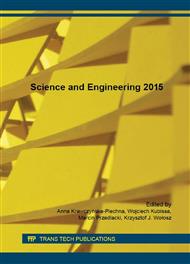p.357
p.363
p.369
p.377
p.383
p.391
p.400
p.408
p.415
The Effect of Leachant pH on the Level of Heavy Metals Release from Industrial Waste
Abstract:
The degree of heavy metals leaching from soils, sediments and waste depends on a number of physical and chemical factors. One of the key parameters governing the leaching process is the pH of the environment in which the waste is located. Laboratory studies aims to reflect the conditions prevailing in the environment, for example on landfill sites. The results of leaching of heavy metals (Zn, Cu, Pb, Ni, Cd, Cr) based on the pH of the eluent were presented in this article. The research material was a metallurgical slag from zinc and lead smelter at the department of refined lead. By the use of HNO3 and NaOH, the deionized water was adjusted to an appropriate pH value of 3; 5; 10.5 and 12, and then, waste samples with grain size of <1 mm, <2.8 mm and <4 mm were submerged in the eluent. Leaching of heavy metals from waste was also examined in deionized water at pH level of 7.4. The study was performed according to the standard PN-EN 12457-2:2006 [13]. The effect of the liquid pH value on the leaching of heavy metals was presented. The lowest concentration of majority of the metals was determined in the inert environment, and high rate was at the pH value of 3 and 10.5. Chromium was the exception, its concentrations in each fraction of the test waste were the lowest at the pH level of 3, and the highest at the pH value equal to 12.
Info:
Periodical:
Pages:
408-414
Citation:
Online since:
November 2015
Authors:
Keywords:
Price:
Сopyright:
© 2015 Trans Tech Publications Ltd. All Rights Reserved
Share:
Citation:


